Text
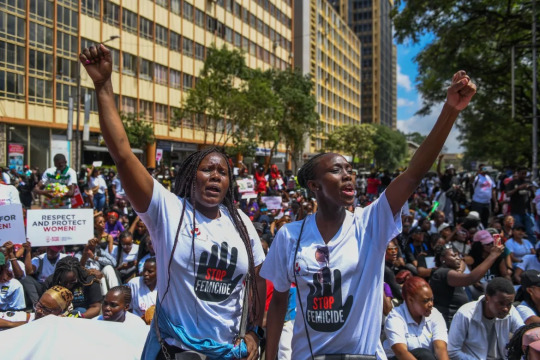
Thousands protest against increasing violence against women in Kenya as they march to the parliamentary building and supreme court in the capital Nairobi [Gerald Anderson/Anadolu Agency]
Published On 27 Jan 202427 Jan 2024
Thousands of people have gathered to protest in cities and towns in Kenya against the recent slayings of more than a dozen women.
The anti-femicide demonstration on Saturday was the largest event ever held in the country against sexual and gender-based violence.
In the capital, Nairobi, protesters wore T-shirts printed with the names of women who became homicide victims this month. The crowd, composed mostly of women, brought traffic to a standstill.
“Stop killing us!” the demonstrators shouted as they waved signs with messages such as “There is no justification to kill women.”
The crowd in Nairobi was hostile to attempts by the parliamentary representative for women, Esther Passaris, to address them. Accusing Passaris of remaining silent during the latest wave of killings, protesters shouted her down with chants of “Where were you?” and “Go home!”
“A country is judged by not how well it treats its rich people, but how well it takes care of the weak and vulnerable,” said Law Society of Kenya President Eric Theuri, who was among the demonstrators.
Kenyan media outlets have reported the slayings of at least 14 women since the start of the year, according to Patricia Andago, a data journalist at media and research firm Odipo Dev who also took part in the march.
Odipo Dev reported this week that news accounts showed at least 500 women were killed in acts of femicide from January 2016 to December 2023. Many more cases go unreported, Andago said.
Two cases that gripped Kenya this month involved two women who were killed at Airbnb accommodations. The second victim was a university student who was dismembered and decapitated after she reportedly was kidnapped for ransom.
Theuri said cases of gender-based violence take too long to be heard in Kenyan court, which he thinks emboldens perpetrators to commit crimes against women.
“As we speak right now, we have a shortage of about 100 judges. We have a shortage of 200 magistrates and adjudicators, and so that means that the wheel of justice grinds slowly as a result of inadequate provisions of resources,” he said.

People gather to protest in an anti-femicide demonstration, the largest event of its kind ever held in Kenya. [Gerald Anderson/Anadolu Agency]

Kenyan media outlets have reported the slayings of at least 14 women since the start of the year. [Gerald Anderson/Anadolu Agency]

A protester holds a Palestinian flag during a march to protest against the rising cases of femicide, in downtown Nairobi. [Brian Inganga/AP Photo]

Women and feminists in Kenya took to the streets to march against the rising cases of femicide. [Brian Inganga/AP Photo]

In Nairobi, protesters wore T-shirts printed with the names of women who became homicide victims this month. [Gerald Anderson/Anadolu Agency]
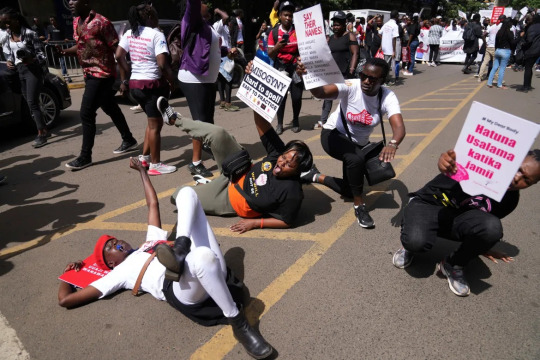
Protesters react against the rising cases of femicide. [Brian Inganga/AP Photo]
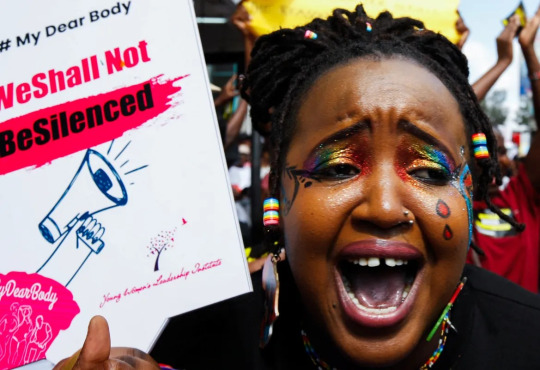
A human rights activist reacts as she attends a protest demanding an end to femicide in the country. [Monicah Mwangi/Reuters]

Protesters gather during the anti-femicide demonstration. [Gerald Anderson/Anadolu Agency]

The crowd, composed mostly of women, brought traffic to a standstill. [Gerald Anderson/Anadolu Agency]
1K notes
·
View notes
Text

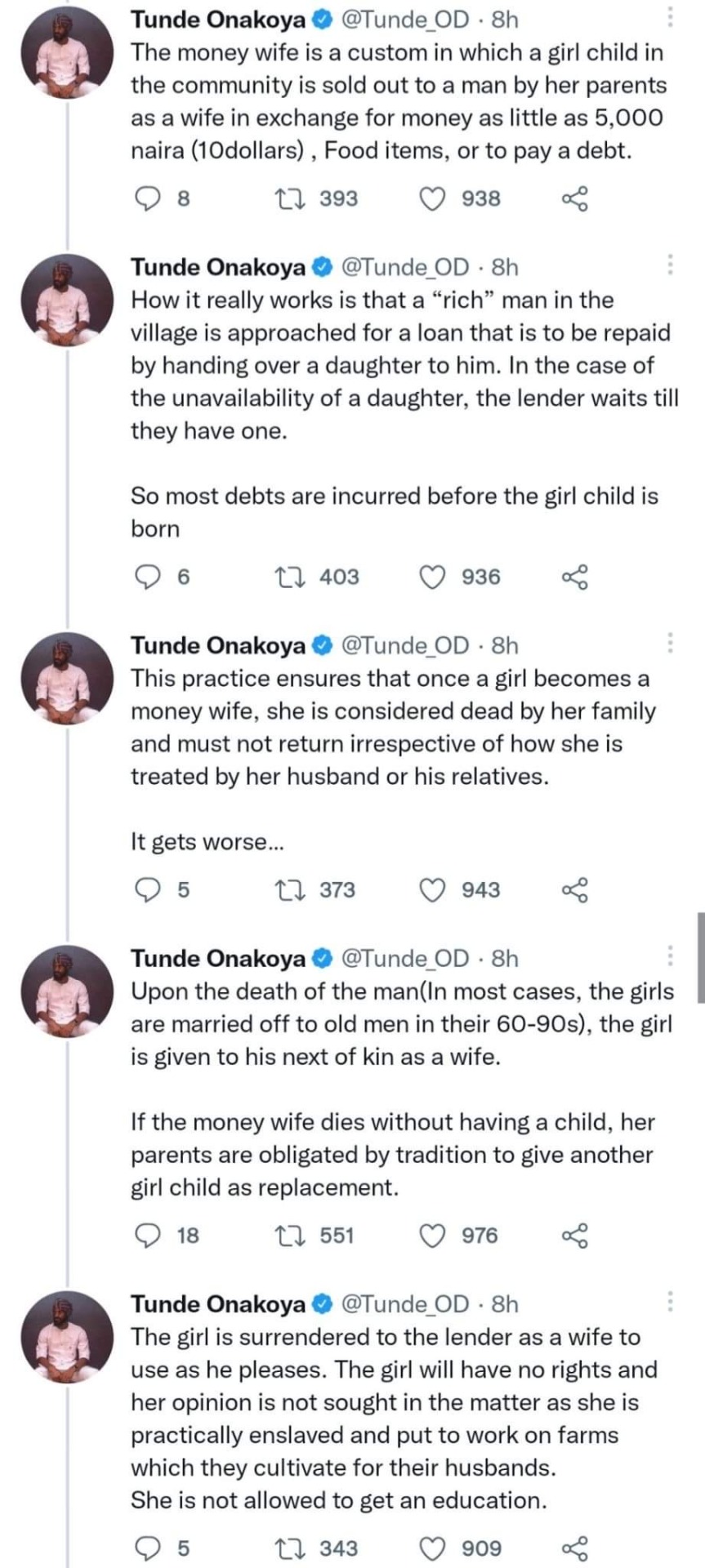
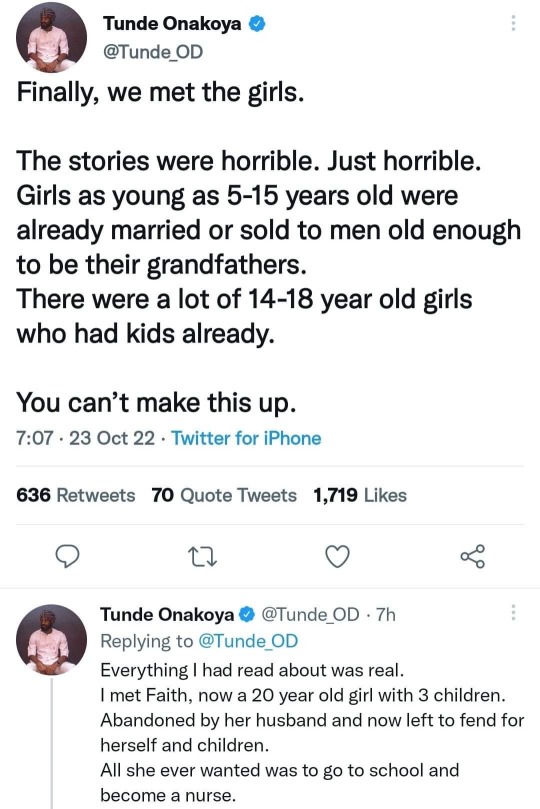



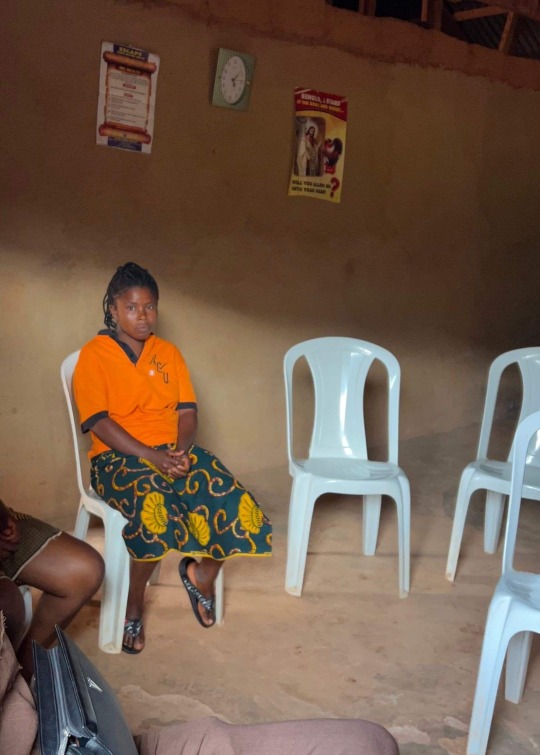

(x) “Money wives” aka culturally accepted sexual slavery of girls as young as 5-14 years in Cross Rivers State, Nigeria
#sex based oppression#patriarchy#cultural misogyny#sex trade#child marriages#child rape#child brides#nigeria#africa
2K notes
·
View notes
Text



screenshots of text messages between porn performer August Ames and a friend, posted on Twitter by Laila Micklewait today. no idea how Laila got these, you can ask her.
Ames died by suicide in December 2017.
#sex based oppression#pornography critical#screenshot#coercion#prostitution#suicide#commodification of women#sexual assault#rape on tape#feminism
2K notes
·
View notes
Text
“Forced marriage — in which one or both parties do not give full, free consent — is recognized globally as a form of modern slavery. My story is far from unique: Around the world, 22 million people were in a forced marriage as of 2021.
Yet, even though the United States acknowledges that forced marriage is a human rights abuse, few laws and policies are in place to prevent or punish it, and the nation has paid such scant attention to this issue that we do not even know how often forced marriage happens here.
What’s more, child marriage remains legal in most U.S. states, even though it is recognized as a form of forced marriage and a human rights abuse. Some 300,000 children were married in the U.S. between 2000 and 2018, mostly girls wed to adult men. At least 60,000 marriages occurred at an age or with a spousal age difference that should have been considered a sex crime.”
Note: The following essay contains descriptions of sexual assault and abuse.
They sent me off to be raped, with a party and a tube of K-Y Jelly.
The lubricant was to reduce the intense physical pain they explained I would endure while being penetrated by a stranger-turned-husband, without foreplay, without consent. Every month. Until death do us part.
The party — a low-budget wedding in 1995 at a Brooklyn venue aptly nicknamed Armpit Terrace — was to distract me from the horrific reality of my forced marriage to the stranger.
“Mazel tov!” they told me, beaming.
In the reclusive Orthodox Jewish community in New York City where I grew up, choices about whether, when and whom I would marry did not belong to me. At home and at the all-girls religious school I attended, where I learned to cook and sew and keep house, I was groomed from early childhood to expect a teen marriage to a stranger my family and a matchmaker would choose for me.
I was allowed to meet the stranger several times before my engagement, but I was not allowed to be alone with him nor to have any physical contact with him. I was a clueless 19-year-old who had never been allowed to “talk to a boy,” and suddenly I was given a matter of hours, over a period of a few weeks, to answer my family and his family and the matchmaker and everyone in the community standing there, tapping their feet, looking at their watches, waiting for me to tell them: You’ll marry this man we chose for you, right?
“No” was never really an option.
During my six-week engagement, I still was not allowed to be alone with the groom nor to have any physical contact with him, which left more time for me to begin experiencing the myriad other abuses that come with a forced marriage.
First, a virginity exam. The groom’s rabbi sent me to an Orthodox Jewish gynecologist, where I was instructed to disrobe, get on the examination table and put my feet in the stirrups. The doctor inserted her gloved fingers into my vagina and confirmed that my hymen was intact.
“Mazel tov!” she told me, beaming.
I attended one-on-one bridal classes, where the curriculum centered on the requirement that I have unprotected sex with my husband on my wedding night and on a monthly basis thereafter. A lifetime of rape.
Yes, the rapes probably would hurt, the bridal class teacher explained. Hence the K-Y Jelly.
“Mazel tov!” she told me, beaming.
My stranger-turned-husband turned out to be violent and abusive. I learned this exactly one week after our wedding, when he became enraged because he had woken up late, and he punched his fist through the wall — hard enough to leave a sizable hole.
His first threat to kill me came only days later. Soon these threats became more frequent, specific and gruesome. He was brimming with creative ideas for how he would end my life, and he took the time to describe them to me in vivid detail. A lifetime of fear.
Yet I was trapped.
My forced marital sex was carefully timed each month for when I was ovulating. The reason for this was obvious: My first child was born 11 months after my wedding, and soon I had a second child.
I love my daughters, but I did not consent to having them. A lifetime of forced parenthood.
This denial of sexual and reproductive rights was not the only shackle preventing me from leaving my marriage. My husband did not allow me to have my own bank account or credit card, and I was taught that, under Orthodox Jewish law, if my husband allowed me to work, any money I earned belonged to him. A lifetime of domestic servitude and financial dependence.
I had limited legal rights too. Under Orthodox Jewish law, only a man can grant a divorce. I, as a woman, did not have the legal right to end my own marriage. A lifetime of being locked in unwanted wedlock.
One escape route for me would have been to move back in with my family as an agunah, a “chained woman” who is bound to a husband who refuses her a divorce. The life of an agunah is brutal; she is shamed for her powerlessness, blamed for her failed marriage and treated as an outcast.
But even this dreadful escape route was closed to me, because my family refused to take me back in. A lifetime of betrayal.
So I remained trapped in my abusive forced marriage. In accordance with Orthodox Jewish law, I was considered “unclean” every time I menstruated. While I was “unclean,” I was prohibited from having physical contact with my husband, sleeping in the same bed as him, handing him anything or undressing or singing in front of him. A lifetime of shame.
Once my period ended, I needed to count seven “clean” days without any menstrual blood, during which time the rules against physical contact continued. To make sure I stayed “clean” for the full seven days, I was required to wear white panties and, twice a day, to insert a white cloth into my vagina, swish it around and inspect it in sunlight to make sure it did not have blood spots. If I found questionable marks on my panties and could not tell whether they were blood, the rabbi would inspect them and give his pronouncement.
And the rabbi would keep my panties. A lifetime of extreme patriarchy.
Each month, after the seven “clean” days, I was forced to strip naked in front of an attendant who watched me immerse in a mikvah, or a ritual bath of rainwater, which frequently left me with a yeast infection and always left me shaking uncontrollably. A lifetime of violation.
All I wanted, every time I left the mikvah, was to take a hot shower and scrub the violation off me. That was prohibited. Instead I was required to go home and have nonconsensual sex with the man who had spent the day describing to me in graphic detail how he was going to murder me. The man who would not let me close the door when I used the bathroom, because “what was I hiding from him in there?”
No matter. I had to get on the bed and spread my legs and forget what had happened to me at the mikvah and ignore the pain while I waited for him to finish, and I had to remind myself how lucky I was that he usually was done after only three or four thrusts. A lifetime straight out of Margaret Atwood’s “The Handmaid’s Tale.”
Forced marriage — in which one or both parties do not give full, free consent — is recognized globally as a form of modern slavery. My story is far from unique: Around the world, 22 million people were in a forced marriage as of 2021.
Yet, even though the United States acknowledges that forced marriage is a human rights abuse, few laws and policies are in place to prevent or punish it, and the nation has paid such scant attention to this issue that we do not even know how often forced marriage happens here.
What’s more, child marriage remains legal in most U.S. states, even though it is recognized as a form of forced marriage and a human rights abuse. Some 300,000 children were married in the U.S. between 2000 and 2018, mostly girls wed to adult men. At least 60,000 marriages occurred at an age or with a spousal age difference that should have been considered a sex crime.
My husband would regularly search through my personal belongings in front of me, including in the pockets of the clothing in my closet and in my bag of tampons under the bathroom sink. A lifetime of subjugation. When I finally realized at age 27 that I was the only person who would help me leave my abusive forced marriage alive and I decided I would secretly save up cash for my escape, I found the only safe hiding place in the house: a box of Whole Grain Total in the pantry.
I saved more than $40,000 in that cereal box over the next five years.
During those years I also defied my community and did something no one in my family had ever done: I became a college student. My husband forbade me from attending classes. I informed him, calmly, that nothing he did to me would stop me from getting my education.
And I did something no one I knew had ever done: I threw out the limp, ugly wig I was required to wear as a married woman to cover my own thick, healthy hair. I walked outside with my uncovered head held high — the equivalent, in that community, of walking outside naked.
My family retaliated immediately by shunning me. One of my sisters notified me that my family was planning to sit shiva — or observe the Jewish mourning ritual for me — as if I had literally died. I have had almost no contact with my family since that day. A lifetime of being dead.
But I graduated from Rutgers University (as commencement speaker, the equivalent of valedictorian) at age 32, and I escaped my abusive forced marriage on my own, with my daughters and my box of Total. I fled the Orthodox Jewish community too, and I rebuilt my life.
In 2011 I founded a nonprofit organization, Unchained At Last, to combat forced and child marriage in the U.S. through direct services and systems change.
The U.S. is one of 193 countries that agree forced and child marriage are harmful practices, particularly for women and girls, and have promised to eliminate these abuses by year 2030 to help achieve gender equality, under the United Nations Sustainable Development Goals. Yet the U.S. is not on track to keep its promise.
I refuse to accept this. Not after I escaped my lifetime of oppression.
We at Unchained are fighting back by providing crucial wraparound services to a long-ignored population: those who are fleeing an existing or impending forced marriage in the U.S. To date we have provided legal and social services, always for free, to nearly 1,000 individuals, to help give them a lifetime of dignity, safety and hope.
We also started a national movement to end child marriage. In the last few years, our groundbreaking research and relentless advocacy have allowed us to help change the law in 10 U.S. states to ban child marriage — a stunning victory for the 7.5 million girls who live in those 10 states — and we are working on the other 40.
A lifetime of preventing other lifetimes of rape.
“Mazel tov!” I now tell myself, beaming, with each triumphant step closer to ending forced and child marriage in the U.S.
Fraidy Reiss is a forced marriage survivor turned activist. She is the founder and executive director of Unchained At Last, a survivor-led nonprofit organization working to end forced and child marriage in the U.S. through direct services and systems change. Fraidy’s research and writing on forced and child marriage have been published extensively, making her one of the nation’s foremost experts on these abuses. She has been featured in books (including as one of the titular women in Hillary and Chelsea Clinton’s “The Book of Gutsy Women”), films and countless television, radio and print news stories.
Need help? Visit RAINN’s National Sexual Assault Online Hotline or the National Sexual Violence Resource Center’s website.
Do you have a compelling personal story you’d like to see published on HuffPost? Find out what we’re looking for here and send us a pitch.
#sex based oppression#testimony#patriarchy#religion as sex based oppression#forced marriages#martial rape#sexual assault#forced pregnancy#human rights violation
111 notes
·
View notes
Text
“The argument within feminism about choice is not new. In the early second wave, feminists were criticised for attacking women who wanted to wear make-up, get married, or who chose to stay home and raise a family. But feminists were not and are not attacking other women for what they choose. Rather we are asking, “What are the forces that shape choices?” and in doing so, we are considering what the rewards and punishments are for the ‘choices’ women make, and naming the potential impacts on girls and young women when they see women embracing ‘choices’ that effectively disempower them.”
- Julie Bindel, Feminism for Women
#julie bindel#feminism for women#quote#books#reference#choice feminism#second wave feminism#patriarchy
60 notes
·
View notes
Text

Scientists in Poland have reportedly developed lab tests that can detect whether people have taken abortion pills—and those tests are already being used to investigate pregnancy outcomes under the country’s abortion ban. This is an alarming development, to say the least, and unfortunately, it feels like it’s only a matter of time before a U.S. state replicates the effort.
According to a bone-chilling piece in the New York Times, Polish scientists have developed tests that can identify both mifepristone and misoprostol, the drugs typically used in a medication abortion. (Though some people do use misoprostol alone.) The studies were part of a research project funded by the Polish government where researchers were able to find evidence of misoprostol in the placenta and mifepristone in a woman’s blood sample. A spokesperson for a prosecutor’s office in Wroclaw confirmed to the Times that Polish authorities have already used the tests to investigate pregnancy outcomes.
god damnit poland.
When abortion is banned, every miscarriage and stillbirth becomes a potential crime scene, and Poland is taking its already dystopian anti-abortion surveillance state to the next level. Poland created a national pregnancy registry in June 2022 and recently had police search the sewers for a fetus to try and prove a woman lied about having a miscarriage. In that case, the police collected her underwear, scissors she used to cut the umbilical cord, and blood from her floor for the investigation. They even wanted to funnel the contents of her home’s septic tank, but cleaners refused. Police claimed the woman lost her pregnancy “as a result of criminal actions” and prosecutors opened proceedings against her, only to drop them months later.
this is the type of shit that conservatives want in America so badly and they will stop at nothing to make sure it happens. this shit is vile.
[source: jezebel]
#well.... this is terrifying#reference#news#abortion#abortion rights#sex based oppression#misogyny#medical misogyny#There Are Now Tests To Detect If Someone Took Abortion Pills#Susan Rinkunas#poland#patriarchy#bodily autonomy
2K notes
·
View notes
Text
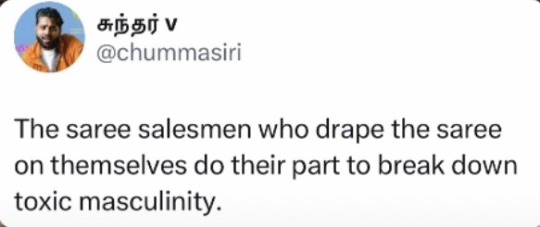
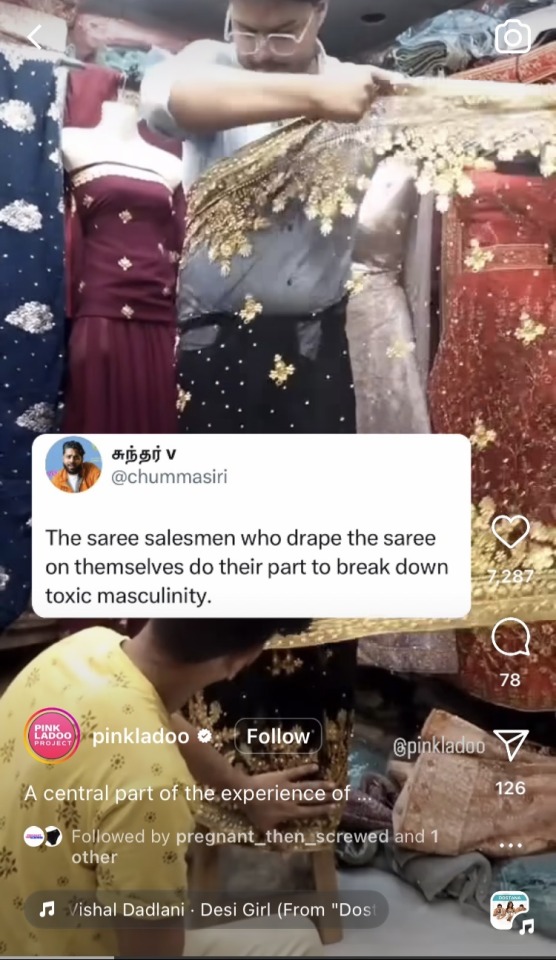


Found this interesting on IG
#not archive#testimony#gender inequality#patriarchy#sex based oppression#tumblr post#womens rights#women in the workplace
764 notes
·
View notes
Text
“No society would permit what happens to women and girls if, at some level, it didn’t have contempt for us.”
- Julie Bindel, Feminism for Women
74 notes
·
View notes
Text
“It was really crucial for me to hear other bisexual women. That’s really what did it for me. Just one meeting with bisexual women and I knew that I was in the right place.”
- Pamela, Bi Lives: Bisexual Women Tell Their Stories
129 notes
·
View notes
Text
Play With It
So I'm reading this book, Crap: A History of Cheap Stuff in America, by Wendy A. Woloson, mostly because I'm fascinated by collectors and how things like Beanie Babies and Precious Moments figurines became huge in the market. I just started the chapter on novelties, gag gifts, joke things like exploding cigars - you know the stuff.
And I was not expecting genuine exploration of "gendered stuff" in this book, but there it was, and damn, was it a punch in the chest. It made me realize exactly why I'd always hated pranks.
In the 1883 book Peck's Bad Boy and His Pa, George Peck argued that the "best" boys are "full of tricks." He explained, "Those who are the readiest to play innocent jokes... are most apt to turn out to be first-class businessmen." Pranking showed a high-spiritedness, a willingness to take risks, and most important, the drive to show oneself as top dog. Perpetuating practical jokes on each other was a way for the best and the brightest to establish hierarchies within bonded groups in the guise of good-natured fun.
The pranks themselves were violations; the "conspiracy" that brought about public embarrassment made them doubly so. The point of performances with theaters of aggression was to distinguish the people who were in on the joke - witnesses and collaborators - from the humiliated, who were not... Likewise, boys could have fun "scaring your mother, uncle and aunts and the neighbors" with the Tarantula (a.k.a. Mexican Spider). Just when the "victim" was starting to smile, a button on the Royal Novelty Company's Squirting Camera could be pushed, releasing "a good squirt of water." "Boys, this is the very best joke and causes no end of fun and laughter," the company promised... The "fun commenced" with the Girl Catcher only after a girl inserted her finger into one end: "No matter how hard she pulls she cannot get away! The harder she pulls the tighter it holds. When you are ready to release her she can get her finger out easily, but not before."
Jokes and gags of this sort created "disruptive" and "provocative" situations that ultimately reinforced the status quo... many jokes and gags involved a distinct gender component. Jokes like Girl Catchers and Squirting Cameras gave boys license to dominate girls as they would later dominate women. What was more, these jokes made girls complicit in their own humiliation, since perpetrators needed ready victims who, because of habits of politeness and deference, would have to be good sports.
Although there was nothing preventing girls from buying and deploying novelty goods, they were told in so many ways that this was not their world. Humor and play belonged to boys more than them. Despite the promise of "fun for all," joke and gag articles were in truth a boy's (and man's) game, and pranking reinforced gender hierarchies. Boys (and men) did things while girls (and women) looked on. Further, boys (and men) had the power - physically, culturally - to do things to girls (and women)... pranking reinforced the widely held assumption that the fairer sex did not possess an innate sense of humor; women didn't even have a legitimate reason for engaging in humorous activities in the first place.
These small consumables opened boys to expansive worlds of limitless possibilities far beyond the confines of the home and its stifling domesticity. Merchandise evoking wonderment, curiosity, and acquisitiveness put within boys' reach, often quite literally, fun, exciting, new, and unapologetically frivolous experiences. In contrast, the toys available to girls prepared them for the domestic work they would be performing for the rest of their lives. Advertisements in girls' magazines dutifully promoted toys offering only inward-looking experiences... meanwhile, boys' literature... promoted toys and games that looked outward, toward adventure, the frontier, and anything else that might seize the imagination.
More sophisticated jokes and gags were predicated on the prescribed roles of girls and women as domestic and domesticated caretakers. Doubly cruel, they not only reinforced women's inferiority but also exploited their submission for a laugh. Women's caretaking sympathies made them susceptible to gags like the false ear bandage and the false chipped tooth. Likewise, their charge to maintain a clean household provided the fodder for many fake ink spills on fine linens... Because an imitation cigarette pretended to obliterate a woman's careful work and ruin her furnishings, it was, apparently, hilarious.
The humor of novelties was not just "transgressive" and "subversive." It was also mean-spirited and corrosive, used to demean and embarrass, "at the expense" of someone else. ... perpetrators of jokes needed not just gag and pranks but also victims to serve as the "butt" of the joke.
How many of these things are still with us today? The notion that "women aren't funny." Or "she just can't take a joke."
The toy stores with their gendered aisles, providing dolls and toy houses and pretend kitchens with very obvious marketing to girls, while the aisles geared towards boys have cars and sports equipment and robots and spaceships and building blocks. Girls' toys are still made for them to "look inward," and boys' toys are still giving them the chance to "look outward." Even "girls" versions of Lego are pink and purple, because apparently we wouldn't want those girls to build anything too serious like a car or a rocket; their sporting equipment is covered in flowers or made by Mattel and rarely holds up to adequate sporting interaction.
I worked at a toy store for a period of time and only once did I have a parent specifically ask for, then purchase, a toy version of a pretend home good for a boy. It was a woman who wanted to buy a toy vacuum cleaner for her son, who was obsessed with the family's vacuum cleaner and wouldn't accept that he couldn't run it all the time. The general idea I got from her was that instead of being a normal adult who owns a vacuum and enjoys keeping their home tidy, she was hoping that her son might grow into a vacuum cleaner retailer, maker, or repairer. Even the "girls' toy" was "looking outward," simply because it was for a boy.
I had a lot of parents ask me for toys for girls that were "less" or "more" in many ways. Where are your dolls with more clothes on? With less makeup on? Do you have a doll that's not wearing a dress? Do you have it in a color that's not pink?
We haven't grown out of this since the 1880s. And I'm tired of the periodic regression that happens with toys. The Lego I used in the 1990's and early 2000's didn't have a purple or pink version. Every kid who bought Lego in the 1990s bought a bucket full of mixed colors. The ads looked like normal kids in their play-clothes - I'm sure you've seen them, because there's been a lot of talk about how the girl in them is dressed "like a boy." No, she's just dressed like a kid.
I looked today for that image and found something actually really amazing. My jaded heart thought that I would see ads from 2023 that had girls playing with the "girl" Lego only when I looked for recent content. Wow, was I wrong.



Lego took the original 1980's ad (bottom center) and used it to create the new ads for International Women's Day this year.
It's not as hard as it looks. We can have gender neutral toys that are still fun for all kids. Toys can just be toys. And if that appeals to you, there's a fantastic group in the UK begging toymakers and book publishers to do just that: Let toys be toys.
This was a whole mess of a ride, and I'm grateful if you got all the way through. It's important for me to know that in some way we've grown beyond gendered novelty, and that we'll continue to grow beyond gendered toys.
#books#reference#quote#Crap: A History Of Cheap Stuff In America#Wendy A. Woloson#female socialization#male socialization#patriarchy#toys#gendered products#trickery in young boys#practical jokery#legos#feminist marketing#pop feminism
237 notes
·
View notes
Text
Scotland’s education secretary ordered a conference on school violence within 48 hours of being sent a video of a girl being lured into a changing room, temporarily blinded with Coke and beaten about the head and face as classmates watched.
Jenny Gilruth and other ministers were bombarded with emails and letters cataloguing assaults on pupils before they decided to act on the problem.
At one point in early 2023, parents, youngsters and staff were sending messages, often containing videos of attacks from social media, several times a week, according to more than 100 pages of correspondence released to The Scotsman under freedom of information laws.
The video of the child being thrashed in the changing room was sent to Gilruth after she took up her job, by a distraught parent who said their daughter had been the victim of “a premeditated attack”.
They feared their child’s life was “at risk”, when — unable to see because of the soft drink in her eyes — other pupils started “kicking her in the face and head, bouncing her head off a wall and kicking her in other areas”.
Other parents outlined allegations of sexual assault, of a primary pupil who was “dragged” into school toilets before being kicked unconscious, and of an assault so serious it “could easily have left the pupil for dead”.
Gilruth, a former teacher, was appointed in March and ordered her summit in May. The government has announced a series of responses.
A study in November found two thirds of staff at more than 500 Scottish schools surveyed had encountered verbal abuse in the previous week. Another 59 per cent had dealt with violence between pupils in the past seven days.
The study’s authors described “pupils persistently infringing rules, making cheeky or impertinent remarks, engaging in general rowdiness, mucking about and deliberately excluding others”. Discipline, the experts authors concluded, had got worse since 2016.
The official report raised particular concern about behaviour at primary schools, which was also reflected in messages to ministers. A parent got in touch with the government to describe a “drastic increase in the level of bullying and violence within the school grounds” at one primary.
Much of the debate on school violence has focused on controversy around low levels of exclusions. School leaders tend not to send disruptive students home, preferring what is called “restorative practice”.
This stance was raised by some of those complaining to the government. “The policy is not working. It is creating tensions between education staff, police and the community,” one correspondent said.
Some teachers and psychologists argue that excessive use of exclusions and suspensions can cause more trouble.
There are also concerns about internet culture, with many incidents being filmed and uploaded to social media and some episodes of bullying or violence being linked to online bigotry against women and girls or minorities.
A Scottish government spokesman said: “Scotland’s schools should be safe learning environments for all. Violent and abusive behaviour towards pupils or staff is completely unacceptable.
“The education secretary has been clear that this must be improved, and has set out five steps to address concerns around behaviour, including bringing forward a national action plan to set out a range of actions at national, local and school level, and a dedicated approach to responding to issues surrounding misogyny.”
#david leask#the times uk#news article#scotlands schools plagued by beatings and sexual assault#school violence#misogyny#male socialization#physical violence#internet culture
61 notes
·
View notes
Photo
I used this piece in one of my button arts. Very powerful imagery.



“Mandevo the lion tried to swipe a buffalo kill from the new mothers, not realising it was meant for their 11-strong brood of cubs. Mandevo suffered a nasty bite to his genitals during the fight in Maasai Mara, Kenya, that left vets no choice but to remove one of his testicles. Photographer Gren Sowerby captured the cat fight on camera, allowing him to raise the alert rangers who moved in to administer veterinary treatment.” x
1K notes
·
View notes
Text
im abt to lose my mind

#not archive#tumblr post#screenshot#social commentary#sex based oppression#misogyny#dehumanization of women#womens education#afganistan#sexualization of women#marketing
8K notes
·
View notes
Text
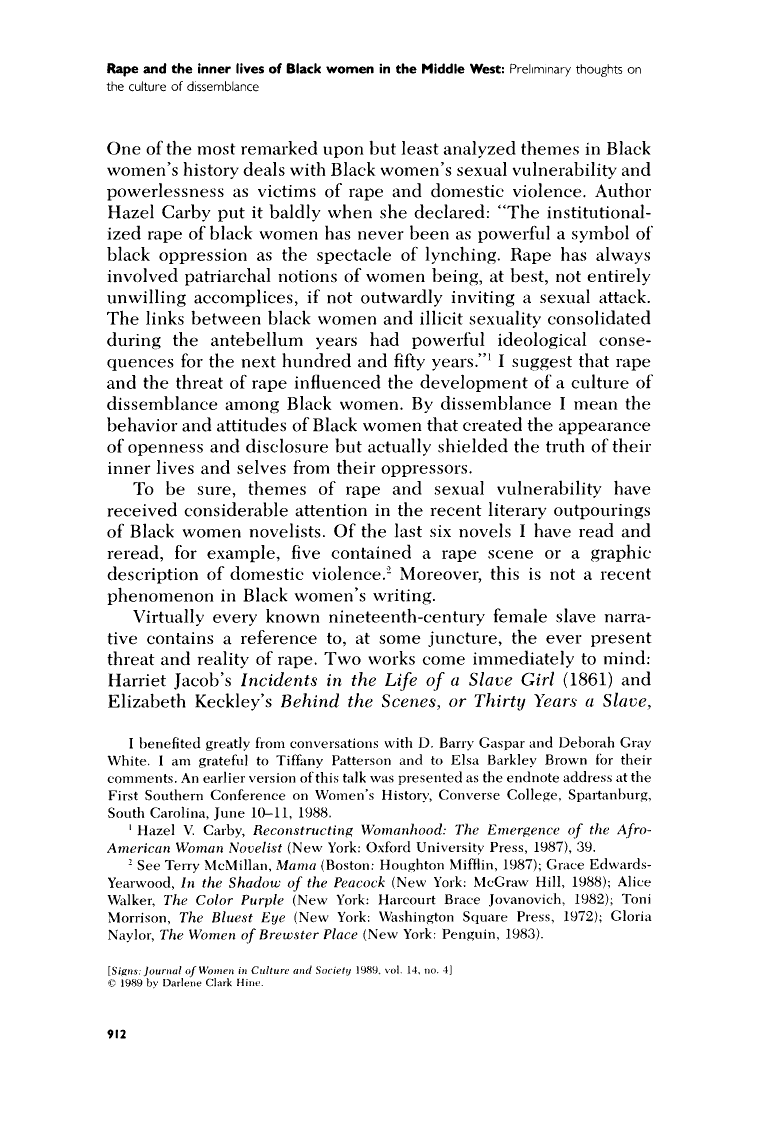
"One of the most remarked upon but least analyzed themes in Black women's history deals with Black women's sexual vulnerability and powerlessness as victims of rape and domestic violence. Author Hazel Carby put it baldly when she declared: "The institutionalized rape of black women has never been as powerful a symbol of black oppression as the spectacle of lynching. Rape has always involved patriarchal notions of women being, at best, not entirely unwilling accomplices, if not outwardly inviting a sexual attack. The links between black women and illicit sexuality consolidated during the antebellum years had powerful ideological consequences for the next hundred and fifty ears."' I suggest that rape and the threat of rape influenced the development of a culture of dissemblance among Black women. By dissemblance I mean the behavior and attitudes of Black women that created the appearance of openness and disclosure but actually shielded the truth of their inner lives and selves from their oppressors. To be sure, themes of rape and sexual vulnerability have received considerable attention in the recent literary outpourings of Black women novelists. Of the last six novels I have read and reread, for example, five contained a rape scene or a graphic description of domestic violence.' Moreover, this is not a recent phenomenon in Black women's writing. Virtually every known nineteenth-century female slave narrative contains a reference to, at some juncture, the ever present threat and reality of rape. Two works come immediately to mind: Harriet Jacob's Incidents in the Life of a Slave Girl (1861) and Elizabeth Keckley's Behind the Scenes, or Thirty Years a Slave,"
Rape and the Inner Lives of Black Women in the Middle West
Darlene Clark Hine
#quote#book#Rape and the Inner Lives of Black Women in the Middle West#darlene clark hine#misogynoir#misogyny#black feminism#slavery#sex based oppression#racism#feminism#feminist theory
203 notes
·
View notes
Text
This entire website is so, so important. Someone archive this and keep it safe. I reccommend EVERYONE go through all of the talks and speeches and read everything. We're failing all these women in not stepping forward, but at the same time, feminists get doxxed and murdered because of the internet. You put your face online and someone can identify you, discredit you, get you fired from your job, and even end your life.
But this has all happened before, and will happen again. We're all having the same arguments and repetitive faux-discourse about terminology, and its all right there in plainsclothes on this website.
Please read it, listen to the women before you. Learn about their research and their studies and the facts and see how we've been dismantled. What has happened to the feminist movement, womens liberation, and move it forward? What did the Womens March do for you personally in your life? What did the MeToo movement change for you permanently? (... what about FreeTheNipple? 😑) What is going on in feminism today that can be comparable? The Netherlands Women Strike didn't even make it into the news. Americans, Abortion is be made Illegal on our watch, in our lives when we are nearly all of voting age. I'm terribly frightened. I feel isolated in my community, but I'm so afraid to speak to anyone. Hear these womens voices. Know you're also not alone.
“She left. She’s not coming back. How do you own her? You kill her.”
- Andrea Dworkin, 1996
A recording of a previously lost Dworkin speech has been made available, online, free, and with no barriers to access.
#these resources are why I made this blog#violence abuse and womens citizenship conference of 1996#feminism#womens liberation movement#womens rights#speeches#audio#history#womens history
827 notes
·
View notes
Text
analyses that seek to talk about the relationship between “femininity,” “masculinity,” and social punishment and reward shoot themselves in the foot when they refuse to define what “femininity” or “masculinity” are and instead just consider them to be two distinct, intangible, immutable qualities of objects or people themselves, such that people just kind of are “feminine” or “masculine”—rather than thinking of different kinds of femininities and masculinities as shifting and multivalent categories that are imposed on people, scripts that people manipulate, or ways in which things are read. people who want to analyse femininity and masculinity for their social disciplinary functions are often unable to really get there because they don’t make this distinction. perhaps they assume that we all know what “femininity” or “masculinity” are and so how these ideas are actually created and applied doesn’t need to be theorised?
this gets especially dicey when you start trying to talk about racialised discourses surrounding gender, and leads you to claims such as “Black men are socially punished for their masculinity”—for the “masculinity” that they just sort of ‘have’—rather than the more productive analysis that the concept of “Black masculinity” is a white invention and sexual fantasy imposed on Black men that serves a specific social-political function re: the policing of Black men and racial corralling, division, and denial of public space justified by viewing Black men as a sexual threat; police murder as an arm of capitalist biopower/ control of populations justified by claiming Black men are a physical threat; the government’s role in systematically destabilising the engine of social reproduction that is the nuclear family in Black communities; &c. &c.. To describe this spectacle of an invented threat as “[Black men’s] masculinity” as though it describes anything actually ‘possessed by’ Black men is, I think, weak analysis to say the very least
#i feel like 'gender is a social construct' disappeared from everyones vocabulary back in 2017 and its just been missing ever since#fantastic post op#not archive#ethics#gender definition#sociology#racism#masculinity#femininity
1K notes
·
View notes
Text
the male gaze distorts reality
started watching movies again (just don't like movies really) and one thing that surprised me was how the male gaze isn't just about staring at hot naked ladies, but how it distorts reality. the male gaze creates 'people' and 'situations' that simply don't exist.
the biggest example to me is the femme fatale. the devious woman using her sexuality as a weapon. whether the trope is a blonde bimbo bubblingly bouncing her boobs, or a sophisticated older brunette casually letting the strap fall off her shoulder and threatening to reveal her bust, they are different incarnations of the same concept. the women are knowingly using the sexual desire of men against them.
i watched a particularly egregious example where a group of women were sent to seduce a group of men, hanging off their shoulders, caressing their chests, with the promise of further sex if they came to another room. the true purpose was to humiliate them by getting them to disrobe in front of other people.
when i was a kid watching these scenes, i was convinced that this was a real thing women did - there were women out there who knowingly used their sexual appeal to get men to do things they otherwise wouldn't. it had to be such a recurrent trope for a reason, right? it even shows up in movies for children - remember the hot pink pegasus seducing hercules's pegasus?
youtube
but as an adult, i find myself confused watching these scenes. i've never seen anything like this happen. i've never met someone who says they do things like this. it's one thing to be flirty and dress in a sexually attractive way to get free drinks, but it's quite another to be so sexually forward to 'deceive' and 'trap' men. not to mention, it's... dangerous. if the man even believes he's being deceived, he can turn violent. it's a foolish move.
maybe the only real life example I can think of is honeypots. but honeypots are actual spies, trained by governments, and spies are selected to have less empathy than the average human being. do we really think that among untrained women there are so many seductresses with the skill of trained spies?
"what about sex workers/prostitutes?" while the honeypot spy is employed by a government agency, prostitutes are paid by the very people they are "seducing." prostitutes have to put on an act - they need to pretend to be the sexually active and perpetually horny woman men both want and fear. but most prostitutes are not like this; they are in it because they need money fast, not because they think fucking strange men for pay is a sexy and desirable career path (fun fact - read the diary of madam pompadour, the most famous courtesan and the embodiment of aristocratic seductress, and you will find she actually did not like having sex with the king and dreaded it. not even our real life courtesans can live up to our fantasies.)
the entire idea of a woman using her sexuality against men is simply a male fantasy - and the flipside is that it's a male anxiety, too.
men wish that women would approach them and find them desirable and initiate sexual intercourse with them, without the men having to do any of the work. there's nothing inherently wrong with fantasizing that a hot person finds you so special and hot that they want to have sex with you right away. men and women of all sexual orientations entertain these secret fantasies.
but then, there's the fear - "what if these hot women are actually only pretending to be interested in me, to get something from me? and i'm too horny to think straight and i actually give it to them?!" and that is the male anxiety, that for a moment, they actually end up losing the upper hand. despite the fact that such a situation is actually pretty rare in real life (I asked several male friends if they had personally or second-hand encountered such a situation in real life, and none could say they had), it is a common trope in fiction. it is especially lascivious in film, where the seduction before the fall can be portrayed in softcore porny ways.
"this is a foolish idea, everyone knows fiction and reality are separate." well, we know they are separate, but do you know which parts? if you don't already know the facts of the situation beforehand, how can you tell when fiction is lying to you and when it's drawing from reality? do you think the young, sexually inexperienced kids watching disney's hercules know that 'seductresses' aren't a common threat when we watch this scene? or will they learn and think "ok, a thing that happens in grownup life is that hot ladies seduce men, and you gotta watch out for them!" what basis does a child or even a teenager have to know this is false? especially when this is a common trope?
"women are sexually available and active - and deceitful" is a harmful trope. when you read about the ancient greeks stereotyping that women are lustful, they don't mean it in an "aww shucks, these girls just love having sex!" kinda way, they mean it in a "women are unfaithful and will use any means to get dick, including taking advantage of their hotness" way (this is why 'whore' is the ultimate insult for women). because if this trope were real, then it would be dangerous, wouldn't it? honeypot spies are dangerous for this reason. luckily for us, it is not real, but the male anxiety surrounding it continues. the male desire/anxiety around it informs porn tropes about 'punished sluts'. it informs incel tropes about the 'cock carousel'.
and this is what i mean when i say the male gaze distorts reality. it fabricates, out of whole cloth, a person that does not exist in any meaningful way - a woman who seduces men while demanding no emotional involvement, who is eager and willing at all times, who can turn the very desire for her existence against those men to get what she wants. she is not repulsed by or afraid of the men she pretends to be attracted to. before, we had to content ourselves with art and novels glorifying this false woman, but film allows her to exist in flesh and blood. cast a real woman, have her speak words and move her body in ways dictated by a man, and suddenly she appears much more real. grow up with enough of these, and even women writers can start to think these "seductresses" are real people. she can try to reclaim her and turn her into a badass boss babe, or she can condemn her as immoral and pathetic, but the deception is complete - the argument is no longer about whether this woman exists (she does not), but about whether she is justified in her ways. the female writer does not realize she was nursed on the male gaze for years, and it will take serious seeing with her own eyes to realize what is the real world and what is male fantasies and fears.
#love this discussion#its always important to be critical of how women are portrayed in the media#not archive#discussion#tumblr post#movie tropes#writing tropes#femme fatale#mean girl trope#male gaze#women in the media#seduction
288 notes
·
View notes